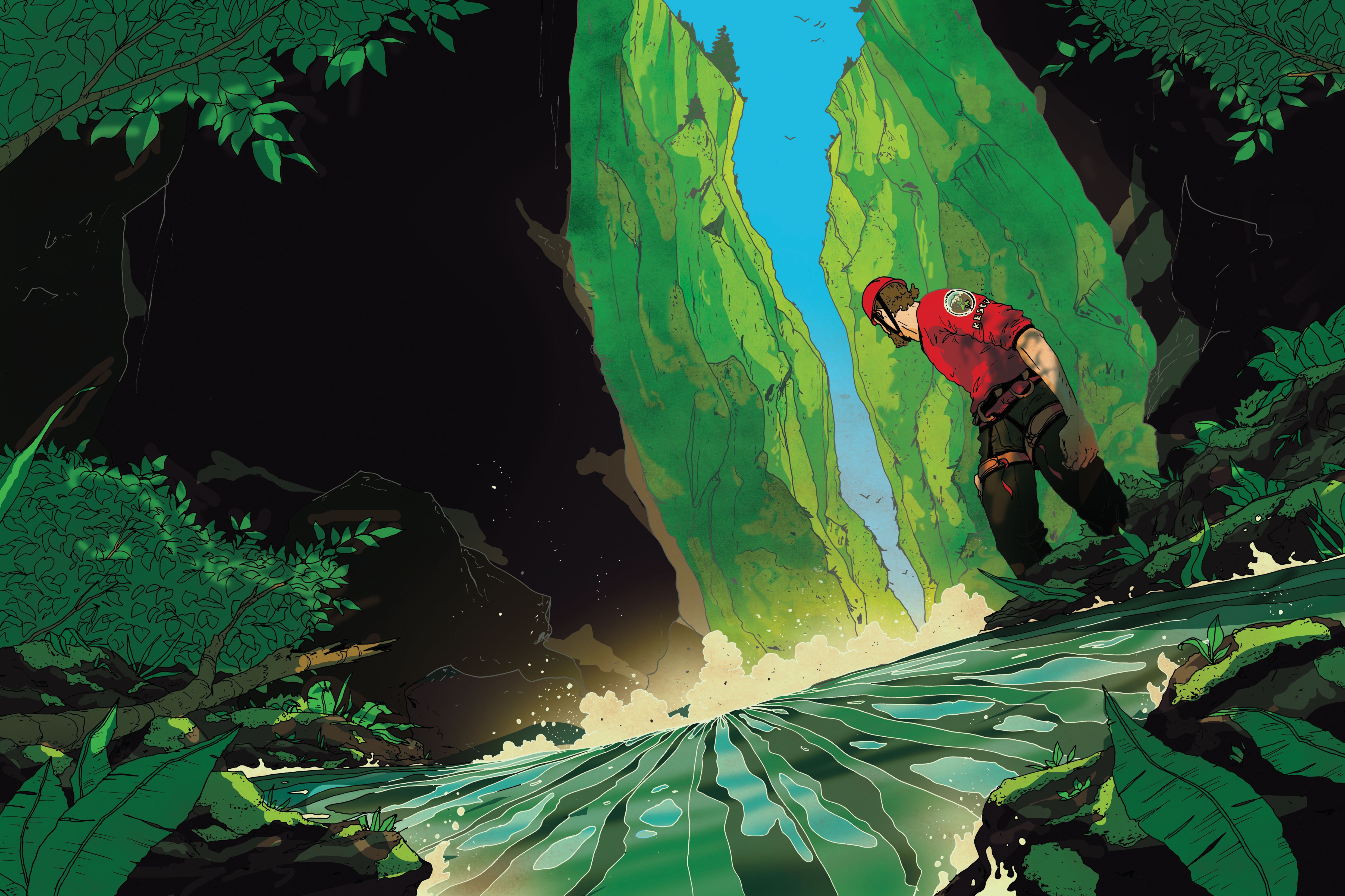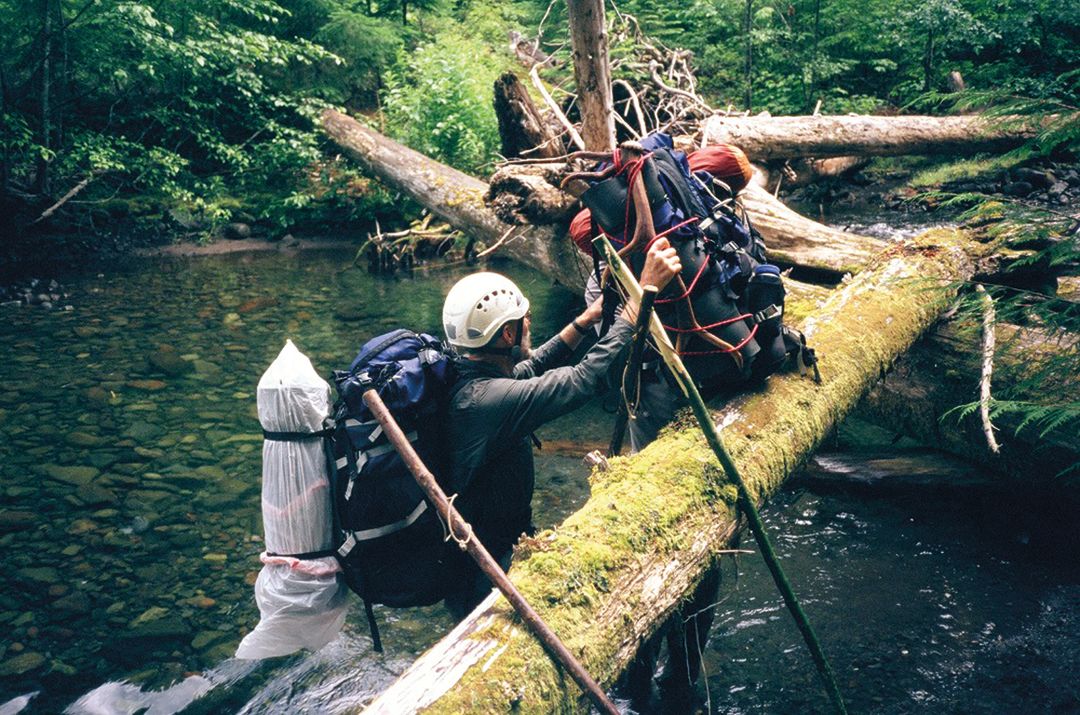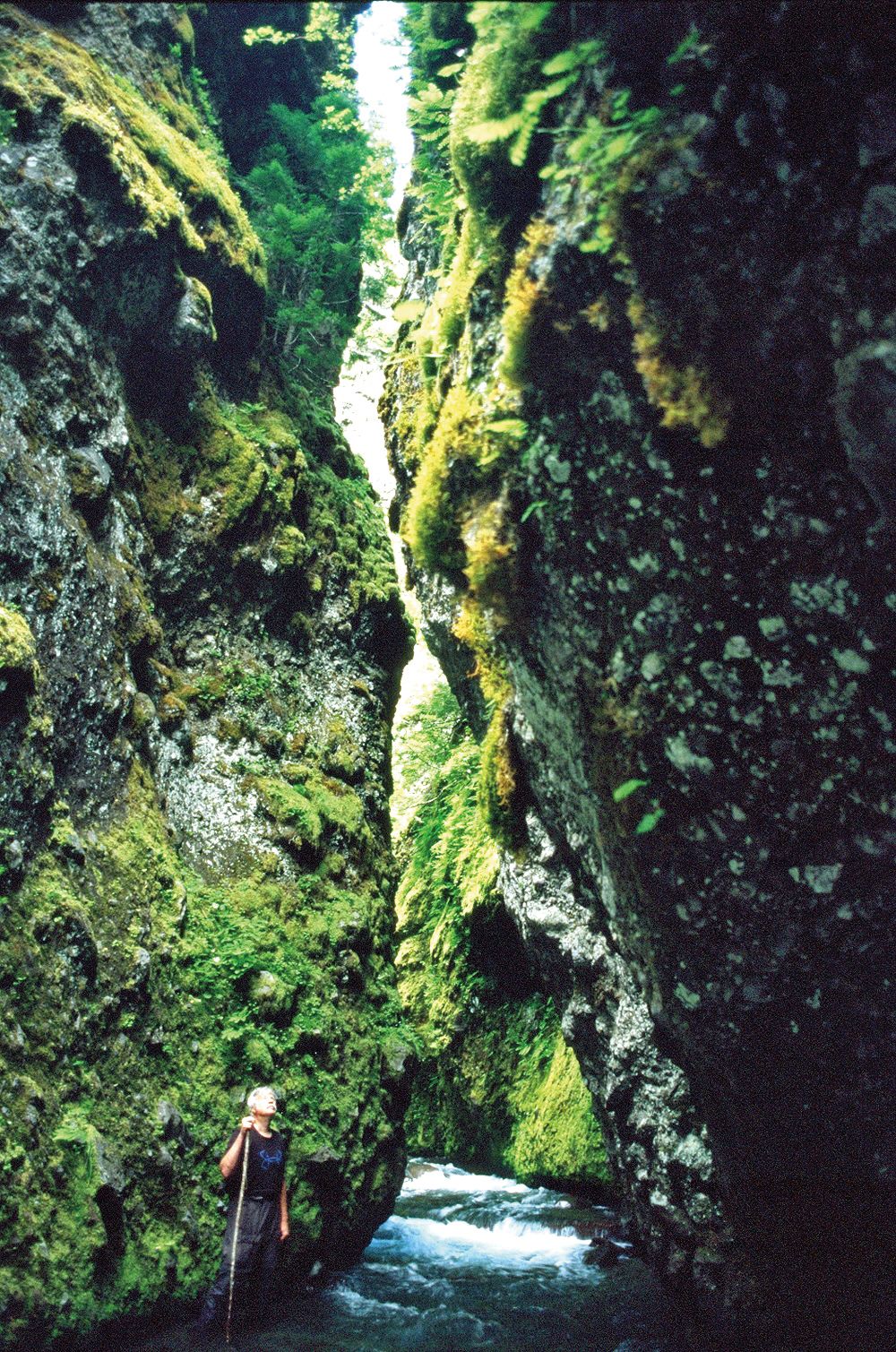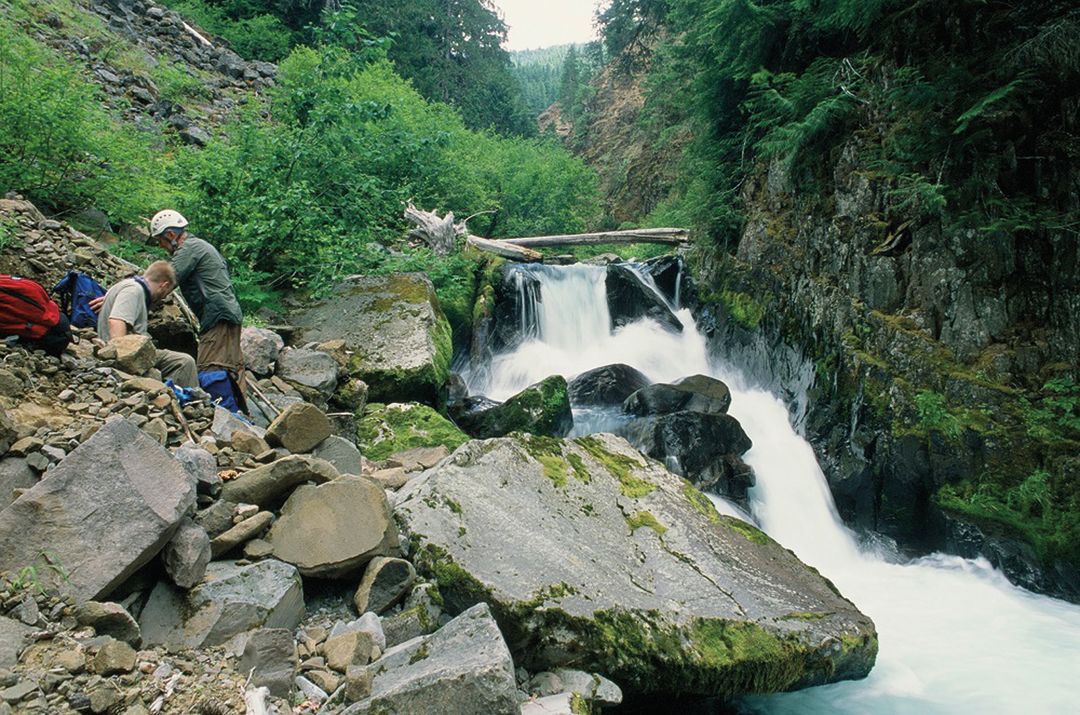
How One Man Found an Uncharted Gem in the Oregon Wilderness
1969 The Mount Jefferson Wilderness. Mike Malone, just out of high school, is old enough to know he just made the biggest mistake of his life. He and a buddy had spent a fall day hunting deer in the thick green forests where they’d dirtied their boots since childhood. On their feet since sunrise, they’d freed their shoulders of their heavy packs with relief as afternoon wore on toward evening, and made camp. But then they decided they still had a little fight left in them, so they picked up their rifles and walked toward the mountainside to see if they could shoot their dinner. They’d left their packs at the campsite.
Soon a fog so thick Malone can’t see his hand in front of his face swarms the two young men. Then comes rain, then snow. They huddle, back to back, against a tree—no flashlight, no compass, no food, no tent. They pray like hell through the night. Malone resolves that if they make it, he will never again put more than a few inches between him and his compass.
Mike Malone has no idea that the object of his life’s greatest adventure is just a short hike from where he sits, half-frozen: a place he won’t find for 41 more years, a place he’ll spot at the right moment, when he just happens to look.

Image: Mike Malone
2010 Marmot, Oregon. Mike Malone, now 59 years old and months from retiring from three decades with the US Forest Service, will still happily fly headfirst into danger. He’s been fighting wildfires since 1976, just a few years after he returned from a tour in Vietnam. And now, as a helicopter manager, he’ll go wherever he’s needed—with his compass, of course (and, these days, a GPS device).
On this morning, Malone rises from his bed at 5 a.m., bolts a bowl of cereal, and exits a home that has become a trophy case of past adventures, decorated with mounted heads of deer and an elk that, living, weighed 1,100 pounds. His Subaru Legacy is packed with everything he needs to fight fire and survive in the woods. When he arrives at the Ripplebrook Ranger Station, halfway between Estacada and Detroit, Malone receives his mission: pick up two resource advisers in the Mount Jefferson Wilderness and fly them to a nearby helipad, where they can join the effort to fight the nearby View Lake fire.
Malone rides above the deep drainage of the South Fork of the North Fork Breitenbush River as the pilot finds clear air amid thick smoke and dips the helicopter just above the treetops. “When you’re flying in a helicopter, it’s sort of like when you’re riding in the front seat of the car,” Malone says. “You’re looking out your windshield in front of you.” They’re moving slowly under the thick blanket overhead, when Malone does something he never does: he looks down. “I think it was fate,” he says.
He watches the South Fork’s whitewater stream twist and squirm through the forest canopy when, suddenly, it disappears into a sliver of darkness, as if emptying into an abyss.
“It was foreboding,” he recalls. “Ominous. Because the river is just disappearing.” And then, moments later, a waterfall bursts into view.
“Wow, we just flew over a slot canyon!” Malone says to the pilot.
“What’s a slot canyon?” the pilot says.
2014 For four years, Malone has been obsessing over a place that—as far as he can tell—no one else has ever seen. He scours the Internet for any mention of a slot canyon near Mount Jefferson. He pores over topographical maps of Oregon, which record extremely subtle nuances of the state’s well-explored landscape. Nothing. Could there really be a gorge hidden in plain sight, in a relatively well-traveled stretch of forest barely 60 miles from Portland? Was what he saw from the helicopter really there? Utah and Arizona are known for slot canyons—thin, deep gorges, sometimes only a few feet wide, crisscrossing the desert landscape like paper cuts. They’re much more rare in Oregon. In a lifetime of exploring the Mount Jefferson area, Malone has never seen one there.
At this point, despite his best efforts, Malone has still never reached the slot canyon. Just months after spotting the anomaly from the helicopter, he planned an expedition to find it with his friend Alan Dyck. The quest proved grueling: the pair waded through ice-cold water and climbed towering piles of fallen timber, bloodying their bare legs until they “looked like hamburger,” Malone remembers. Traveling one mile took four hours; then they encountered a 20-foot waterfall. “That stopped our whole expedition right there,” Malone says.

Image: Mike Malone
Over the following years, the longer he went without finding any information about this mysterious slot canyon, the quieter he got about it. “I knew it was something cool,” he says, “and I wanted to be the first to try to document it.”
So now, in July 2014, Malone traverses the same rough terrain, this time with his friend Craig Edberg and Craig’s son, Erik—experienced climbers ready to conquer the 20-foot waterfall that halted Malone before. They find that time has smoothed the way: a rockslide filled the 20-foot drop on one side, and the trio scuttles up without climbing gear. Even with that obstacle removed, Craig Edberg wonders if they’re searching for something that’s not really there.
“We had been hiking all day and it’s like, ‘Sooo, are we going to find anything up here or not? Or are we chasing an illusion?’” he says.
Four hours and less than three miles into the group’s second day of hiking, as they climb another spine of fallen timber, Malone looks ahead and sees a narrow hallway with mossy green cliffs 150 feet tall. Silence reigns: no birds chirping, no breeze rustling the forest around them. “Almost like you’re standing in a photograph,” Malone says.
At the canyon’s entrance, Malone grasps his hiking stick in one hand and lets his head fall back, eyes looking toward the sky where he flew years before. Here he is, finally. Exhausted. Victorious. In his leisure hours, Malone has read about Valhalla, a mystical canyon in Norse mythology where fallen warriors feast. Now, he stands at his own personal Valhalla, the name he’ll give to what proves to be a half-mile-long cleft in the forest, with nine major waterfalls—one enclosed in a dark cave—and almost two dozen small ones, hidden between towering cliffs carpeted in bright green moss.
He wonders if anyone has ever seen this before.
1992 Breitenbush Lake. A 12-year-old boy has gone missing off the Pacific Crest Trail.
Jon Sears’s phone rings: “Can you come?” the voice on the other end of the line asks. Sears belongs to the Corvallis Mountain Rescue Unit (CMRU), an all-volunteer band dedicated to getting climbers and hikers out of danger. The boy had been walking on the trail with his father but “didn’t want to be there and was pissin’ and moanin’,” one CMRU member will later recall. “So his father said, ‘You just go on ahead and we’ll see you at the car.’” After the boy disappeared, sheriffs, dogs, horses, and helicopters searched the area. But when the steep, rocky terrain proved difficult, the CMRU got the call to help. Six members of the rescue team traverse the unstable, steep landscape, shouting into the forest, scanning the water for a body. “They gave us this mission to go down and look up that stream,” Sears remembers, “and they talked like we would be back by noon that day. It turned out it was noon the following day.”
As they venture into the thick forest, the team loses radio contact. A deep gorge slowly narrows into “a slot canyon,” according to a team member’s account, filled with several waterfalls. Sears fears he might fall, his feet slipping and scrambling on the mossy, wet rocks as the team scales the waterfalls. “How are we going to get through this thing?” he wonders.
The boy has been discovered alive, elsewhere, and is on his way home by the time the CMRU team scrambles out of the slot canyon the next day.
February 2016 Oregon Public Broadcasting unveils “Discovering Valhalla,” a documentary in the network’s Oregon Field Guide series that chronicles Malone’s fixation on the slot canyon, and tracks a team of expert climbers as they navigate its entirety, clambering down the waterfalls studding its half-mile length. In the lush footage, Malone and other members of the team revel in the idea that they’ve found something undiscovered. “We knew that the real test was when thousands of people saw it on TV,” Malone says.
And sure enough, producers at OPB soon receive word of the CMRU trip there in 1992, and call Sears to confirm. Sears, 62 now, says that although he stood in the canyon before Malone, he still considers Malone’s encounter with the canyon something of discovery. “I hope he doesn’t feel too bad,” he says, “because he’s the first one to have gone there willingly, and liked it.”
But the canyon changed the lives of his rescue unit, too. He considers the members of that 1992 mission his closest friends. Two of the members of his team later married. They came to the slot canyon by accident. And they left, he says, as something much stronger, much greater than they were before.
In 1492, Christopher Columbus set foot on an island in what’s now known as the Bahamas, named it San Salvador, and called it a discovery—even though the Lucayan people already lived there. In 1909, Robert Peary and Matthew Henson claimed the first expedition to the North Pole, despite conflicting accounts of earlier journeys there.
Discovery, says Will Roseman, executive director of the Explorer’s Club—a 112-year-old, New York–based organization whose members have included Peary, Henson, Charles Lindbergh, Neil Armstrong, Buzz Aldrin, and Michael Collins—is always a loaded concept, and often “nebulous.” In the 21st century, it can seem that everything is charted, but that is not true. “A lot of people say to me, ‘What is there left to explore?’” Roseman says. “Last year, our members found seven new animals. Who would have thought?”

Image: Mike Malone
Roseman calls Malone’s encounter with Valhalla a discovery, because it provided the first thorough documentation of the slot canyon. “Maybe the best way to think about it is Newton’s discovery of gravity,” he says. “Obviously it’s always been there, or we would have floated off earth. But Newton described it and evaluated it.”
A discovery today doesn’t have to mean standing somewhere for the first time, he says. It can simply mean making the world look at something a different way.
Valhalla, Malone says, isn’t his first “discovery,” and hopefully won’t be his last. “There’s lots of places I still have on my list to explore,” he says. But Valhalla piqued his curiosity far beyond anywhere else he has encountered in a life of roaming the Oregon wild: a place he thought about constantly in those years after he spotted it from the air.
The Forest Service has since set up a website for the “Mount Jefferson Slot Canyon, known unofficially as Valhalla Canyon,” noting that it was located during Malone’s 2010 flyover. Because the place is so remote, Malone says it would be nearly impossible to build any sort of trail system to reach it, and adds that “people would be opposed to that, because of the philosophy of ‘keeping wilderness wild.’”
Malone says he doesn’t need all the credit. He couldn’t have gotten there alone. What Malone wants from all his hard work is something simple, something he can enjoy as he traverses the backcountry. Something everyone—even the people who’ll never stand in the halls of Valhalla, look up, and see a narrow sliver of starry sky—can enjoy.
“I think it would be cool if one of the local microbreweries came out with a beer that they call ‘Valhalla,’” he says. A beer. One Malone can stuff into his pack and drink beside the fire after his compass and his curiosity lead him to his next great adventure.




